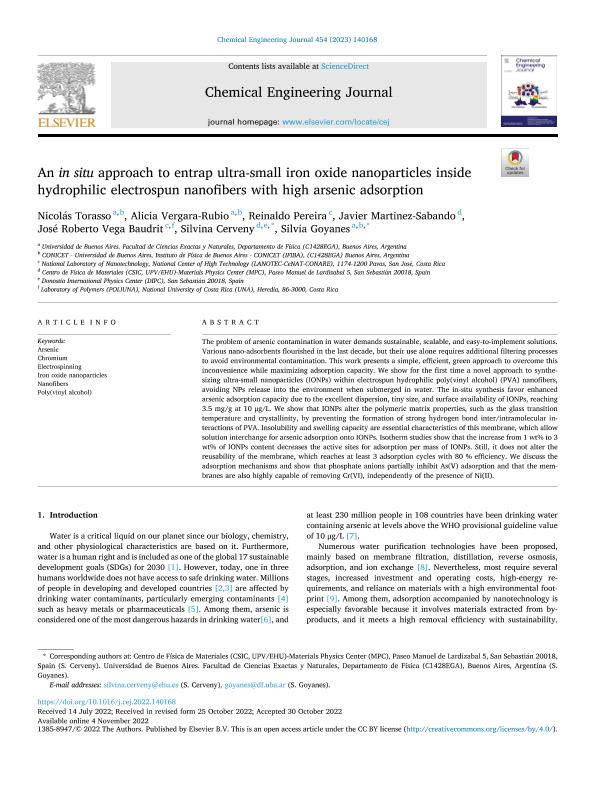Artículo
An in situ approach to entrap ultra-small iron oxide nanoparticles inside hydrophilic electrospun nanofibers with high arsenic adsorption
Torasso, Nicolás; Vergara Rubio, María Alicia ; Pereira, Reinaldo; Martinez Sabando, Javier; Vega Baudrit, José Roberto; Cerveny, Silvina; Goyanes, Silvia Nair
; Pereira, Reinaldo; Martinez Sabando, Javier; Vega Baudrit, José Roberto; Cerveny, Silvina; Goyanes, Silvia Nair
 ; Pereira, Reinaldo; Martinez Sabando, Javier; Vega Baudrit, José Roberto; Cerveny, Silvina; Goyanes, Silvia Nair
; Pereira, Reinaldo; Martinez Sabando, Javier; Vega Baudrit, José Roberto; Cerveny, Silvina; Goyanes, Silvia Nair
Fecha de publicación:
02/2023
Editorial:
Elsevier Science SA
Revista:
Chemical Engineering Journal
ISSN:
1385-8947
Idioma:
Inglés
Tipo de recurso:
Artículo publicado
Clasificación temática:
Resumen
The problem of arsenic contamination in water demands sustainable, scalable, and easy-to-implement solutions. Various nano-adsorbents flourished in the last decade, but their use alone requires additional filtering processes to avoid environmental contamination. This work presents a simple, efficient, green approach to overcome this inconvenience while maximizing adsorption capacity. We show for the first time a novel approach to synthesizing ultra-small nanoparticles (IONPs) within electrospun hydrophilic poly(vinyl alcohol) (PVA) nanofibers, avoiding NPs release into the environment when submerged in water. The in-situ synthesis favor enhanced arsenic adsorption capacity due to the excellent dispersion, tiny size, and surface availability of IONPs, reaching 3.5 mg/g at 10 μg/L. We show that IONPs alter the polymeric matrix properties, such as the glass transition temperature and crystallinity, by preventing the formation of strong hydrogen bond inter/intramolecular interactions of PVA. Insolubility and swelling capacity are essential characteristics of this membrane, which allow solution interchange for arsenic adsorption onto IONPs. Isotherm studies show that the increase from 1 wt% to 3 wt% of IONPs content decreases the active sites for adsorption per mass of IONPs. Still, it does not alter the reusability of the membrane, which reaches at least 3 adsorption cycles with 80 % efficiency. We discuss the adsorption mechanisms and show that phosphate anions partially inhibit As(V) adsorption and that the membranes are also highly capable of removing Cr(VI), independently of the presence of Ni(II).
Archivos asociados
Licencia
Identificadores
Colecciones
Articulos (IIIA)
Articulos de INSTITUTO DE INVESTIGACION E INGENIERIA AMBIENTAL
Articulos de INSTITUTO DE INVESTIGACION E INGENIERIA AMBIENTAL
Articulos(IFIBA)
Articulos de INST.DE FISICA DE BUENOS AIRES
Articulos de INST.DE FISICA DE BUENOS AIRES
Citación
Torasso, Nicolás; Vergara Rubio, María Alicia; Pereira, Reinaldo; Martinez Sabando, Javier; Vega Baudrit, José Roberto; et al.; An in situ approach to entrap ultra-small iron oxide nanoparticles inside hydrophilic electrospun nanofibers with high arsenic adsorption; Elsevier Science SA; Chemical Engineering Journal; 454; 4; 140168; 2-2023; 1-10
Compartir
Altmétricas



